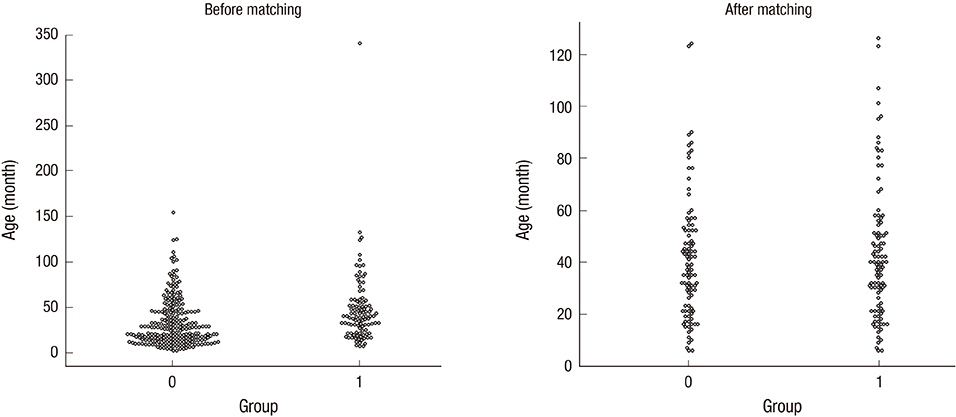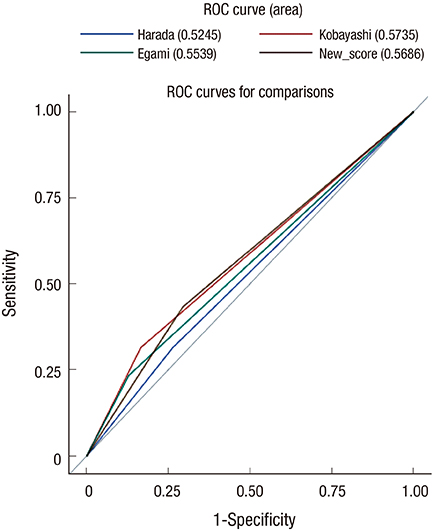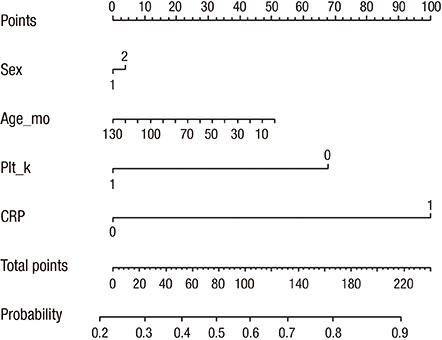J Korean Med Sci.
2017 Dec;32(12):1991-1996. 10.3346/jkms.2017.32.12.1991.
Verification of Current Risk Scores for Kawasaki Disease in Korean Children
- Affiliations
-
- 1Division of Pediatric Cardiology, Department of Pediatrics, Yonsei University College of Medicine, Gangnam Severance Hospital, Seoul, Korea. lucyeun@yuhs.ac
- KMID: 2396376
- DOI: http://doi.org/10.3346/jkms.2017.32.12.1991
Abstract
- The purpose of this study was to evaluate and assess the compatibility of current risk scoring systems from Japan that were developed to predict intravenous immunoglobulin (IVIG) resistance in patients with Kawasaki disease (KD). The authors previously investigated another prediction model for patients with refractory KD in Korea. A retrospective study involving 350 patients with KD who were admitted between January 2014 and December 2015 was performed. Patients younger than 2 years were excluded for the propensity score matching in this study. Patients were classified into IVIG responders and IVIG resistance groups. The well-known Harada, Kobayashi, and Egami risk scores were calculated for each patient, and the proportion of high-risk patients was compared between the two groups for each risk score. Logistic regression analysis revealed that platelets, C-reactive protein (CRP) levels, and aspartate aminotransferase levels were independent predictors of IVIG resistance. Multivariate analysis suggested that platelets and CRP were risk factors. Risk-scoring systems from Japan have good specificity but low sensitivity. Among the three risk scoring systems, the Kobayashi risk score demonstrated significant differences between the IVIG resistance and IVIG responder groups in Korean patients with KD. It is very important to identify IVIG-resistant patients to protect them from ongoing coronary arterial lesion(s); therefore, early prediction and timely optimal additional treatment is of significant benefit. It would be helpful to construct a highly sensitive, exclusive scoring system for Korean patients with KD.
MeSH Terms
-
Aspartate Aminotransferases
C-Reactive Protein
Child*
Humans
Immunoglobulins
Immunoglobulins, Intravenous
Japan
Korea
Logistic Models
Mucocutaneous Lymph Node Syndrome*
Multivariate Analysis
Propensity Score
Retrospective Studies
Risk Factors
Sensitivity and Specificity
Aspartate Aminotransferases
C-Reactive Protein
Immunoglobulins
Immunoglobulins, Intravenous
Figure
Cited by 1 articles
-
Factors Predicting Resistance to Intravenous Immunoglobulin and Coronary Complications in Kawasaki Disease: IVIG Resistance in Kawasaki Disease
Ji Whan Han
Korean Circ J. 2018;48(1):86-88. doi: 10.4070/kcj.2017.0376.
Reference
-
1. Burns JC, Glodé MP. Kawasaki syndrome. Lancet. 2004; 364:533–544.2. Ayusawa M, Sonobe T, Uemura S, Ogawa S, Nakamura Y, Kiyosawa N, Ishii M, Harada K;. Revision of diagnostic guidelines for Kawasaki disease (the 5th revised edition). Pediatr Int. 2005; 47:232–234.3. JCS Joint Working Group. Guidelines for diagnosis and management of cardiovascular sequelae in Kawasaki disease (JCS 2013). Digest version. Circ J. 2014; 78:2521–2562.4. Cimaz R, Sundel R. Atypical and incomplete Kawasaki disease. Best Pract Res Clin Rheumatol. 2009; 23:689–697.5. Kibata T, Suzuki Y, Hasegawa S, Matsushige T, Kusuda T, Hoshide M, Takahashi K, Okada S, Wakiguchi H, Moriwake T, et al. Coronary artery lesions and the increasing incidence of Kawasaki disease resistant to initial immunoglobulin. Int J Cardiol. 2016; 214:209–215.6. Harada K. Intravenous gamma-globulin treatment in Kawasaki disease. Acta Paediatr Jpn. 1991; 33:805–810.7. Kobayashi T, Inoue Y, Takeuchi K, Okada Y, Tamura K, Tomomasa T, Kobayashi T, Morikawa A. Prediction of intravenous immunoglobulin unresponsiveness in patients with Kawasaki disease. Circulation. 2006; 113:2606–2612.8. Egami K, Muta H, Ishii M, Suda K, Sugahara Y, Iemura M, Matsuishi T. Prediction of resistance to intravenous immunoglobulin treatment in patients with Kawasaki disease. J Pediatr. 2006; 149:237–240.9. Kim BY, Kim D, Kim YH, Ryoo E, Sun YH, Jeon IS, Jung MJ, Cho HK, Tchah H, Choi DY, et al. Non-responders to intravenous immunoglobulin and coronary artery dilatation in Kawasaki disease: Predictive parameters in Korean children. Korean Circ J. 2016; 46:542–549.10. Park HM, Lee DW, Hyun MC, Lee SB. Predictors of nonresponse to intravenous immunoglobulin therapy in Kawasaki disease. Korean J Pediatr. 2013; 56:75–79.11. Haycock GB, Schwartz GJ, Wisotsky DH. Geometric method for measuring body surface area: a height-weight formula validated in infants, children, and adults. J Pediatr. 1978; 93:62–66.12. Manlhiot C, Millar K, Golding F, McCrindle BW. Improved classification of coronary artery abnormalities based only on coronary artery z-scores after Kawasaki disease. Pediatr Cardiol. 2010; 31:242–249.13. Sleeper LA, Minich LL, McCrindle BM, Li JS, Mason W, Colan SD, Atz AM, Printz BF, Baker A, Vetter VL, et al. Evaluation of Kawasaki disease risk-scoring systems for intravenous immunoglobulin resistance. J Pediatr. 2011; 158:831–835.e3.14. Davies S, Sutton N, Blackstock S, Gormley S, Hoggart CJ, Levin M, Herberg JA. Predicting IVIG resistance in UK Kawasaki disease. Arch Dis Child. 2015; 100:366–368.15. Fu PP, Du ZD, Pan YS. Novel predictors of intravenous immunoglobulin resistance in Chinese children with Kawasaki disease. Pediatr Infect Dis J. 2013; 32:e319–e323.16. Kim GB, Han JW, Park YW, Song MS, Hong YM, Cha SH, Kim DS, Park S. Epidemiologic features of Kawasaki disease in South Korea: data from nationwide survey, 2009–2011. Pediatr Infect Dis J. 2014; 33:24–27.17. Sato S, Kawashima H, Kashiwagi Y, Hoshika A. Inflammatory cytokines as predictors of resistance to intravenous immunoglobulin therapy in Kawasaki disease patients. Int J Rheum Dis. 2013; 16:168–172.18. Sano T, Kurotobi S, Matsuzaki K, Yamamoto T, Maki I, Miki K, Kogaki S, Hara J. Prediction of non-responsiveness to standard high-dose gamma-globulin therapy in patients with acute Kawasaki disease before starting initial treatment. Eur J Pediatr. 2007; 166:131–137.19. Tremoulet AH, Best BM, Song S, Wang S, Corinaldesi E, Eichenfield JR, Martin DD, Newburger JW, Burns JC. Resistance to intravenous immunoglobulin in children with Kawasaki disease. J Pediatr. 2008; 153:117–121.20. Matsubara T, Ichiyama T, Furukawa S. Immunological profile of peripheral blood lymphocytes and monocytes/macrophages in Kawasaki disease. Clin Exp Immunol. 2005; 141:381–387.




